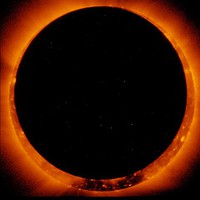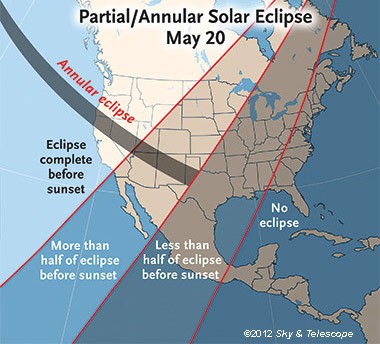Gear Up for the Solar Eclipse
By Kim Mullin
Safely viewing a solar eclipse takes special equipment—ask an adult for help now so you are ready!

Those who see the May 20 annular eclipse will see a ring of sun around a dark center. The above photo of the January 2011 annular eclipse was taken by the Hinode satellite. Image: NASA.
Solar Eclipse to be Visible from Most of North America on May 20
As the Earth makes its rotation on May 20, many people around the world will be in for a treat—a view of a solar eclipse! If you live in North America, be ready to witness this celestial event in the afternoon or early evening... unless you live on the East Coast. The eclipse's path won't include the eastern edge of North America, so residents there will need to visit their favorite science news outlets for pictures.
What Will You See?
A solar eclipse happens when our moon passes between Earth and the
Sun, briefly blocking our view of the Sun. There are three main types
of eclipses: total, partial, and annular. A total eclipse occurs when
the Sun and moon line up exactly, so the moon completely blocks our
view of the Sun. During a total eclipse, we can see the sun's "corona"
(a band of plasma that surrounds the sun) around the edges of the
moon. A partial eclipse occurs when the Sun and moon are not exactly
lined up, so the moon only blocks part of the Sun, temporarily making
the Sun look crescent-shaped. An annular eclipse is when the Sun and
moon are lined up, but the moon appears smaller than the Sun, so a
thin ring of the Sun is visible around the edges of the moon. Think
giant solar doughnut in the sky!
On May 20, lucky viewers, including many in the U.S., will see an annular eclipse, but most sky-watchers will see only a partial eclipse. The image below shows the timing of the eclipse for viewers in various parts of the U.S. and indicates the thin arc of the annular viewing path. You can also check NASA's interactive map to see if you will be able to see the annular eclipse, what some refer to as a solar "ring of fire."
You may wonder why some people will see a partial eclipse and others will see an annular eclipse when everyone is viewing the same Sun and moon. In fact, people on some parts of the globe will not see an eclipse at all on May 20. This is because people in different locations are viewing the Sun and moon at different angles. Think of it this way: you could hide from a friend by crouching behind a sofa, but if your friend started to walk around the sofa, she would see more and more of you the further around she came. Your view of this week's solar eclipse depends on where you live!
IMPORTANT REMINDER: Viewing an Eclipse Can Be Dangerous
Never look at the sun or an eclipse directly with your eyes. Doing so can cause permanent blindness or other severe damage. According to Jane Houston Jones of NASA, "Though only six percent of the sun's surface will be visible at greatest eclipse, it will still be 60,000 times brighter than the full moon and will damage your eyes if you look directly at it." According to experts, you need to "filter out more than 99% of the Sun's light before it reaches your eyes." Even so, from solar-viewing glasses to special telescope filters, or even a "projection" of the eclipse onto another surface, there are safe viewing techniques if you plan ahead. Sky and Telescope's article about how to safely view a solar eclipse can help you understand your options.










